Victorian Architecture and Society
by Alex Balmforth
When we speak of 'Victorian Architecture' we generally reference the period from the time when the Industrial Revolution was moving on apace and the population continued to migrate from the countryside to the towns. The voracious appetite of manufacturing industries stimulated the necessity for more and more workers to be recruited. These new workers had to be housed cheaply and effectively. However workers' welfare and healthy homes were never to be included as part of their employers brief.
Over and under, 'Back to back' and cellar dwellings proliferated. Three families, in one dwelling was a customary model. This concept is best explained by two families and often including their extended family living back to back, with a third family occupying the cellar. It was not unknown for as many as 40+ occupants living in a building that by modern standards would shelter one family. During the mid 19th Century, *in his book 'The Condition of the Working Classes in England' Frederick Engels chronicled the slums of Manchester and his observations, even today make for shameful reading. Sanitation in these slums was rudimentary and almost none existent. As many as 50 persons would share one insanitary lavatory. As a consequence cholera and numerous other dreadful diseases were endemic. In nearby Ashton under Lyne, close by the area known as Penny Meadow a cholera cemetery was established in which an unknown number from an outbreak were interred.
*Originally printed in German as 'Die Lage der arbeitenden Klasse in England'
19th Century 'Model' Villages
Locally we identify several not altogether unselfish exceptions, in nearby Halifax we have Colonel Ackroyd's model village at Copley, built in 1844 and followed by his later (C1860) 'Akroyden' not forgetting Sir Titus Salt's 'Saltaire' a little outside Bradford. However; it has to be conceded that Ackroyd sustained the back-to-back template. As to some degree did Salt.
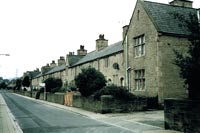
Copley
|
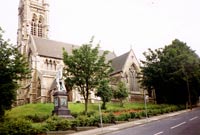
Akroyden
|
I quote from Ackroyd's essay, 'On improved Dwellings for the Working Classes.' (reference, Copley Village)
"A picturesque outline was adopted in a modified Old English Style, approximating to the character of many old dwellings in the neighbourhood and also in harmony with the beautiful site… in front of the cottages, facing the river are allotment gardens flanked by a recreation ground; and on the bank is seated the village school with its separate play yards. In the opposite site it is proposed to erect a church…"
Even closer to home we have the Moravian settlement in Droylsden, with its roots in the late 18th century. Ashton had the late 19C benefactor Hugh Mason, and the planned town (later to be cruelly vandalised by 1960's Town Planners)
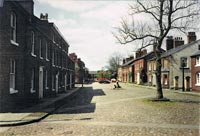
Fairfield Moravian,
Droylsden
|
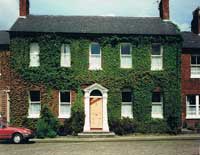
Fairfield Moravian,
Droylsden |
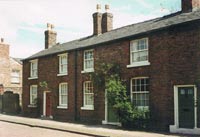
Fairfield Moravian,
Droylsden |
However there were no such altruists in Oldham; as the town's population grew its largely unplanned speculative housing stock increased and so did the poverty of its population combined with a paucity of architectural ideas…
Many of the workers houses were of the back-to-back, over and under style. Popular also was the 'yard' concept, even giving them numbers, and the soubriquet 'Union Yard' followed by their identifying number.
The Victorians really did have Jerry (Jury) building down to a fine art. Generally employers cared little for the wellbeing of their disenfranchised workers, however resentment and revolution fomented. Witness 'Peterloo' (1819) the repeal of the Corn Laws and William IV's and Lord Grey's stitch up bill, the woefully inadequate 1832 'Reform Bill'
From circa 1830 onwards Civic and ecclesiastical building was encouraged, but still the workers were studiously ignored, and many public buildings were constructed on a grand scale with the vain hope that this magnificence would have a 'trickle down' effect on the vernacular dwellings.
Edwin Chadwick's (born Longsight, Manchester 1800-d1890) infamous 1842 'Report on the Sanitary Condition of the Labouring Population' observed,
"The walls are only half a brick thick, what bricklayers call a brick noggin, and the materials are slight and unfit for purpose, back to back, without ventilation or drainage… :"
Mind, the Victorian ruling classes concerned themselves more with the effect overcrowding would have on morals, seemingly blind to the fact that they themselves were responsible for most of the sins against the population.
More Altruists
One such champion of the people was 'Honest' John Fielden, a Todmorden mill owner who alongside William Cobbett in 1832 became the first MP for Oldham - a position he held until 1847. Fielden was firstly a 'Friend' (Quaker) secondly a Methodist and finally a Unitarian. He went on to prepare a number of papers, in 1832, he published his tract 'The Mischief's and Iniquities of Paper Money', and in 1836, a pamphlet, 'The Curse of the Factory System'. Fielden was also a vigorous supporter of the Temperance Movement. Additionally he was also instrumental in introducing (alongside Cobbett) the 'Ten Hours Act' an act that limited the hour's children could work in factories. This Act allegedly incited riots for which both he and his friend Cobbett were investigated.
The relatively local (Huddersfield) radical Tory, Richard Oastler, (b 1789 – 1861) friend and supporter of the Abolitionists and Poor Law Reform wrote,
"It is the pride of Britain that a slave cannot exist on her soil. ... Let truth speak out, appalling as the statement may appear. The fact is true. Thousands of our fellow-creatures and fellow-subjects, both male and female, the miserable inhabitants of a Yorkshire town, (Yorkshire now represented in Parliament by the giant of anti-slavery principles) are this very moment existing in a state of slavery, more horrid than are the victims of that hellish system 'colonial' slavery. Richard Oastler (c1847)"
Oastler, who championed strikes and sabotage to further the mill workers rights was eventually gaoled (for what on which appeared to be a trumped up charge) when his creditors suddenly called in unpaid debts.
But still the problem of decent housing was not addressed.
All across the North of England and indeed wherever the factory system was implemented, housing on the whole was pitifully basic and altogether substandard.
Charles Dickens addressed the subject in his novel 'Hard Times' in which a fictional town 'Coketown' was described,
"Coketown was a town of 'red brick', or a brick that would have been red if the smoke and ashes had allowed it. It was a town of machinery and tall chimneys… it had a black canal in it, and a river that ran purple with ill smelling dye… nature was as strongly bricked out as the killing airs and gasses were bricked in."
The fictional town was said to be Preston, but it could have been any Northern textile town.
'1848 The Year of Revolutions'
As the 1789 French Revolution and Napoleon Bonaparte had shocked to the roots European heads of state and governments, especially in Great Britain were the Chartist's were again agitating; historically their demands included,
-
Every man over 21 who was not a criminal or insane should be allowed to vote.
-
Voting should be done in secret.
-
Candidates should not need to be rich or own property to become a Member of Parliament.
-
All Members of Parliament should be paid for doing their job.
-
All electoral areas should represent the same number of people.
-
Elections should be held annually.
Chartists were the embryonic precursor of Trade Unions. Through their efforts and agitation the position of the worker gradually improved…
Throughout the 19th Century many bills were introduced into Parliament, however precious little was to address housing
(NB I rarely champion or recommend any research by Wikipedia, however there is a section on 19th century 'Factory Acts' which is quite detailed and seems to be accurate, however it is best to verify in hard copy.)
Late in the 19th century a bill was introduced to limit terraced housing to 8 buildings and any continuation building was to include a passage.
It is sad to relate that until the end of the Great War, when conditions had to improve, Oldham was a largely unplanned slum.
Contributed by Alex Balmforth
